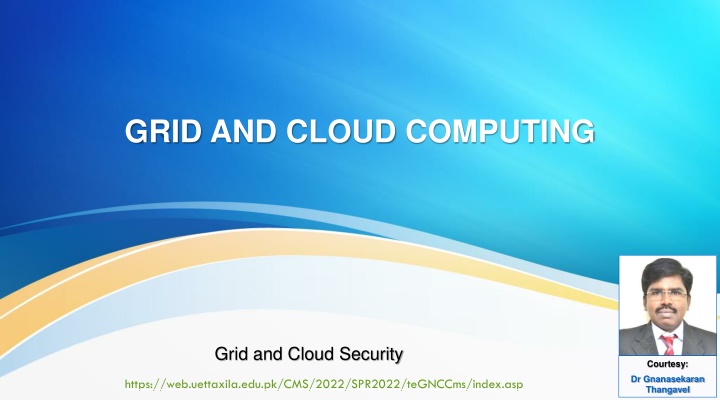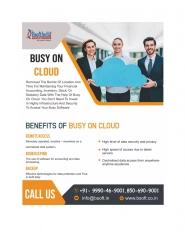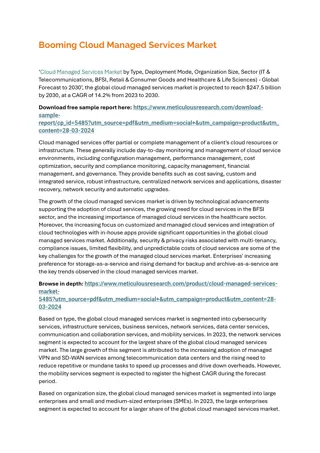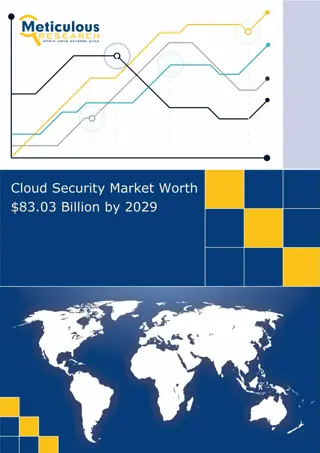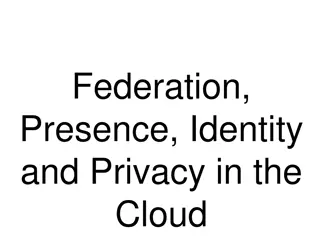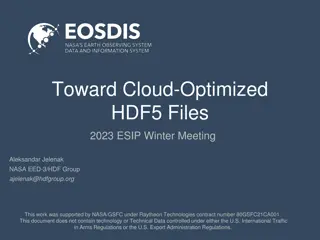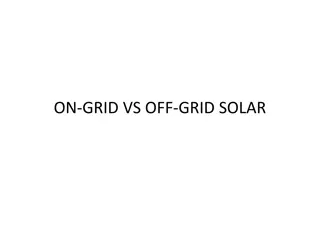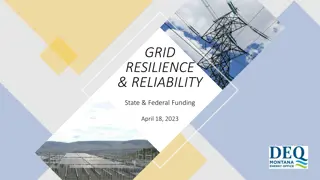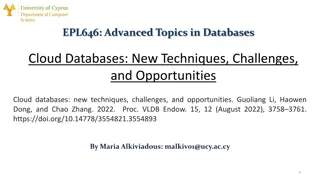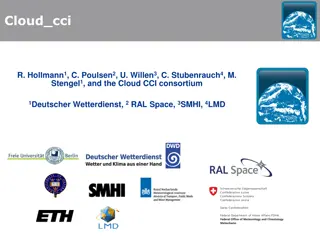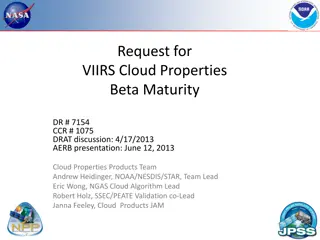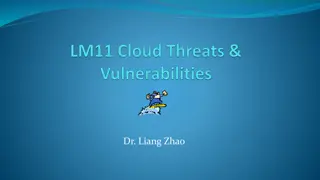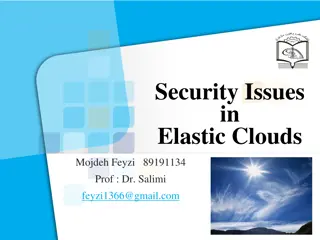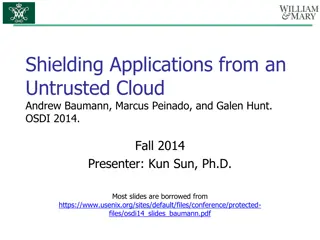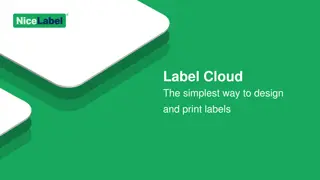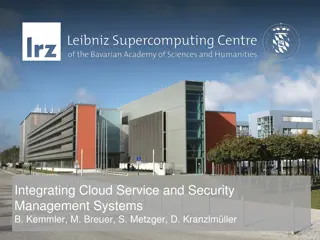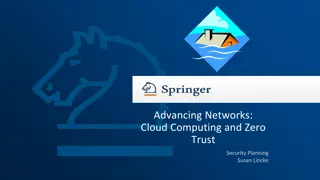Grid and Cloud Security
Trust models, reputation, and security demands in the grid and cloud computing environment. Learn about key security issues, authentication methods, and infrastructure security in cloud computing. Gain insights into the dynamic nature of trust values and the importance of context in establishing trust.
Download Presentation

Please find below an Image/Link to download the presentation.
The content on the website is provided AS IS for your information and personal use only. It may not be sold, licensed, or shared on other websites without obtaining consent from the author.If you encounter any issues during the download, it is possible that the publisher has removed the file from their server.
You are allowed to download the files provided on this website for personal or commercial use, subject to the condition that they are used lawfully. All files are the property of their respective owners.
The content on the website is provided AS IS for your information and personal use only. It may not be sold, licensed, or shared on other websites without obtaining consent from the author.
E N D
Presentation Transcript
GRID AND CLOUD COMPUTING Grid and Cloud Security Courtesy: Dr Gnanasekaran Thangavel https://web.uettaxila.edu.pk/CMS/2022/SPR2022/teGNCCms/index.asp
UNIT 7: GRID AND CLOUD SECURITY Trust models for Grid security environment Authentication and Authorization methods Grid Security Infrastructure (GSI) Cloud Infrastructure Security: Network, Host and Application- level aspects of data security, provider data and its security, Identity and access management architecture, IAM practices in the cloud, SaaS, PaaS, IaaS availability in the cloud, Key privacy issues in the cloud. 3/12/2025 2
Definition of Trust Trust is the firm belief in the competence of an entity to behave as expected such that this firm belief has a dynamic value associated with the entity and is subject to the entity s behavior and applies only within a specific context at a given time. Trust Trust value is a continuous and dynamic value in the range of [0,1] 1 means very trustworthy 0 means very untrustworthy It is built on past experience It is context based (under different context may have different trust value) 3/12/2025 3
Reputation When making trust-based decisions, entities can rely on others for information regarding to a specific entity. The competence information regarding a specific entity x is defined as the reputation of entity x. Definitionof Reputation The reputation of an entity is an expectation of its behavior based on other entities observations or information about the entity s past behavior within a specific context at a given time. Evaluating Trust and Reputation Trusts decays with time Entities may form alliances and they may trust their allies and business partners more than others Trust value is based on the combination of direct trust and reputation 3/12/2025 4
Trust models for Grid security environment Many potential security issues may occur in a grid environment if qualified security mechanisms are not in place. These issues include 1. Network sniffers, 2. Out-of-Control access, 3. Faulty operation, 4. Malicious operation, 5. Integration of local security mechanisms, 6. Delegation, 7. Dynamic resources and services, 8. Attack provenance, and so on. 3/12/2025 5
Security Demand (SD) and Trust Index (TI) On the one hand, a user job demands the resource site to provide security assurance by issuing a Security Demand (SD). On the other hand, the resource site needs to reveal its trustworthiness, called its Trust Index (TI). These two parameters must satisfy a security assurance condition: TI SD during the job mapping process. When determining its security demand, users usually care about some typical attributes. These attributes and their values are dynamically changing and depend heavily on the trust model, security policy, accumulated reputation, self-defense capability, attack history, and site vulnerability. Three challenges are outlined below to establish the trust among grid sites: 3/12/2025 6
Challenge 1: Integration with existing Systems and Technologies. The resources sites in a grid are usually heterogeneous and autonomous. It is unrealistic to expect that a single type of security can be compatible with and adopted by every hosting environment. At the same time, existing security infrastructure on the sites cannot be replaced overnight. Thus, to be successful, grid security architecture needs to step up to the challenge of integrating with existing security architecture and models across platforms and hosting environments. 3/12/2025 7
Challenge 2: Interoperability with different Hosting environments. Services are often invoked across multiple domains and need to be able to interact with one another. The interoperation is demanded at the protocol, policy, and identity levels. For all these levels, interoperation must be protected securely. Challenge 3: Construction of Trust Relationships among interacting hosting environments. Grid service requests can be handled by combining resources on multiple security domains. Trust relationships are required by these domains during the end-to-end traversals. A service needs to be open to friendly and interested entities so that they can submit requests and access securely. 3/12/2025 8
Trust Model Resource sharing among entities is one of the major goals of grid computing. A trust relationship must be established before the entities in the grid interoperate with one another. To create the proper trust relationship between grid entities, two kinds of trust models are often used. 1. One is the PKI-based model, which mainly exploits the PKI to authenticate and authorize entities. 2. The other is the reputation-based model. 3/12/2025 9
Public Key Infrastructure (PKI) A third-party validation authority (VA) can provide this entity information on behalf of the CA Registration and issuance of certificates at and by a certificate authority (CA) Valid and correct registration is done at registration authority (RA). A public key infrastructure (PKI) is a set of roles, policies, and procedures needed to create, manage, distribute, use, store, and revoke digital certificates and manage public-key encryption. 3/12/2025 10
A Generalized Trust Model 3/12/2025 11
A Generalized Trust Model conti Figure in previous slide 11 shows a general trust model. The three major factors which influence the trustworthiness of a resource site. An inference module is required to aggregate these factors. Followings are some existing inference or aggregation methods. An intra-site fuzzy inference procedure is called to assess defense capability and direct reputation. Defense Capability is decided by the firewall, intrusion detection system (IDS), intrusion response capability, and anti-virus capacity of the individual resource site. Direct Reputation is decided based on the job success rate, site utilization, job turnaround time, and job slowdown ratio measured. Recommendation Trust is also known as secondary trust and is obtained indirectly over the grid network. 3/12/2025 12
Reputation-Based Trust Model In a reputation-based model, jobs are sent to a resource site only when the site is trustworthy to meet users demands. The site trustworthiness is usually calculated from the following information: the Defense Capability, Direct Reputation, and Recommendation Trust. The Defense Capability refers to the site s ability to protect itself from danger. It is assessed according to such factors as intrusion detection, firewall, response capabilities, anti-virus capacity, and so on. Direct Reputation is based on experiences of prior jobs previously submitted to the site. The Reputation is measured by many factors such as prior job execution success rate, cumulative site utilization, job turnaround time, job slowdown ratio, and so on. A positive experience associated with a site will improve its reputation. On the contrary, a negative experience with a site will decrease its reputation. 3/12/2025 13
Fuzzy-Trust Model In this model, the job security demand (SD) is supplied by the user programs. The trust index (TI) of a resource site is aggregated through the fuzzy-logic inference process over all related parameters. Specifically, two-level fuzzy logic can be used to estimate the aggregation of numerous trust parameters and security attributes in the scalar quantities representation that are easy to use in the job scheduling and resource mapping process. The TI is normalized as a single real number with 0 representing the condition with the highest risk at a site and 1 representing the condition which is totally risk-free or fully trusted. The fuzzy inference is accomplished through four steps: fuzzification, inference, aggregation, and defuzzification. The second salient feature of the trust model is that if a site s trust index cannot match the job security demand (i.e., SD > TI ), this trust model could deduce detailed security features to guide the site security upgrade as a result of tuning the fuzzy system. 3/12/2025 14
Authentication and Authorization Methods The major authentication methods in the grid include passwords, PKI, and Kerberos. The password is the simplest method to identify users, but the most vulnerable one to use. The PKI is the most popular method supported by GSI . To implement PKI, a trusted third party called the certificate authority (CA) is used. Each user applies a unique pair of public and private keys. The public keys are issued by the CA by issuing a certificate, after recognizing a legitimate user. The private key is exclusive for each user to use and is unknown to any other users. A digital certificate in IEEE X.509 format consists of the username, user public key, CA name, and a secret signature of the user. 3/12/2025 15
Authorization for Access Control The authorization is a process to exercise access control of shared resources. Decisions can be made either at the access point of service or at a centralized place. Typically, the resource is a host that provides processors and storage for services deployed on it. Based on a set predefined policies or rules, the resource may enforce access for local services. The central authority is a special entity which is capable of issuing and revoking policies of access rights granted to remote accesses. The authorization server makes the final authorization decision. 3/12/2025 16
Three Authorization Models Figure above shows three authorization models in use. 1. The subject-push model 2. The resource-pulling model 3. The authorization agent model 3/12/2025 17
Three authorization models The subject-push model is shown at the top diagram. The user conducts handshake with the authority first and then with the resource site in a sequence. The resource-pulling model puts the resource in the middle. The user checks the resource first. Then the resource contacts its authority to verify the request, and the authority authorizes at step 3. Finally, the resource accepts or rejects the request from the subject at step 4. The authorization agent model puts the authority in the middle. The subject check with the authority at step 1 and the authority makes decisions on the access of the requested resources. The authorization process is complete at steps 3 and 4 in the reverse direction. 3/12/2025 18
Grid Security Infrastructure (GSI) The grid is increasingly deployed as a common approach to constructing dynamic, inter domain, distributed computing and data collaborations, still there is lack of security/trust between different services . It is still an important challenge of the grid. The grid requires a security infrastructure with the following properties: 1. Easy to use; 2. Conforms with the Virtual Organization s (VO s) security needs while working well with site policies of each resource provider site; and 3. Provides appropriate authentication and encryption of all interactions. 3/12/2025 19
Grid Security Infrastructure (GSI) conti.. GSI is well-known security solution in the grid environment, GSI is a part of the Globus Toolkit and provides fundamental security services needed to support grids, including supporting for message protection, authentication, delegation, and authorization. GSI enables secure authentication and communication over an open network and permits mutual authentication across and among distributed sites with single sign-on capability. No centrally managed security system is required, and the grid maintains the integrity of its members local policies. GSI supports both message-level security, which supports the Web Service Security (WSS) standard and the WS-Secure Conversation specification to provide message protection for SOAP messages, and transport-level security, which means authentication via Transport Layer Security(TLS) with support for X.509 proxy certificates. 3/12/2025 20
GSI Functional Layers Globus Toolkit (GT) provides distinct WS and pre-WS authentication and authorization capabilities. Both are built on the same base, namely the X.509 standard, entity certificates and proxy certificates, which are used to identify persistent entities such as users and servers to support the temporary delegation of privileges to other entities, respectively. GSI may be thought of as being composed of four distinct functions: message protection, authentication, delegation, and authorization. 3/12/2025 21
GSI Functional Layers conti TLS (transport layer security) or WS-Security and WS-Secure Conversation (message level) are used as message protection mechanisms in combination with SOAP. X.509 End Entity Certificates or Username and Password are used as authentication credentials. X.509 Proxy Certificates and WS-Trust are used for delegation. An Authorization Framework allows for a variety of authorization schemes, including a grid-mapfile Access Control List (ACL) is defined by a service, a custom authorization handler, and access to an authorization service via the SAML protocol. In addition, associated security tools provide for the storage of X.509 credentials, the mapping between GSI and other authentication mechanisms and maintenance of information used for authorization. 3/12/2025 22
GSI Functional Layers conti The web services portions of Globus Toolkit (GT) use Simple Object Access Protocol (SOAP) as their message protocol for communication. Message protection can be provided either by 1. Transport-Level Security, which transports SOAP messages over TLS, or by 2. Message-Level Security, which is signing and/or encrypting Portions of the SOAP message using the WS-Security standard. 3/12/2025 23
GSI Functional Layers conti The X.509 certificates used by GSI are conformant to the relevant standards and conventions. Grid deployments around the world have established their own CAs based on third-party software to issue the X.509 certificate for use with GSI and the Globus Toolkit. GSI also supports delegation and single sign-on through the use of standard X.509 proxy certificate. Proxy certificate allow bearers of X.509 to delegate their privileges temporarily to another entity. For the purposes of authentication and authorization, GSI treats certificate and proxy certificate equivalently. Authentication with X.509 credentials can be accomplished either via TLS, in the case of transport-level security, or via signature as specified by WS-Security, in the case of message-level security. 3/12/2025 24
Authentication and Delegation To reduce or even avoid the number of times the user must enter his passphrase when several grids are used or agents (local or remote) request services on behalf of a user, GSI provides a delegation capability and a delegation service that provides an interface to allow clients to delegate (and renew) X.509 proxy certificates to a service. The interface to this service is based on the WS-Trust specification. A proxy consists of a new certificate and a private key. The key pair that is used for the proxy, that is, the public key embedded in the certificate and the private key, may either be regenerated for each proxy or be obtained by other means. The new certificate contains the owner s identity, modified slightly to indicate that it is a proxy. The new certificate is signed by the owner, rather than a CA 3/12/2025 25
Trust Delegation GSI has traditionally supported authentication and delegation through the use of X.509 certificate and public keys. As a new feature in Globus Toolkit, GSI also supports authentication through plain usernames and passwords as a deployment option. As a central concept in GSI authentication, a certificate includes four primary pieces of information: (1) a subject name, which identifies the person or object that the certificate represents; (2) the public key belonging to the subject; (3) the identity of a CA that has signed the certificate to certify that the public key and the identity both belong to the subject; and (4) the digital signature of the named CA. X.509 provides each entity with a unique identifier (i.e., a distinguished name) and a method to assert that identifier to another party through the use of an asymmetric key pair bound to the identifier by the certificate. 3/12/2025 26
Risks and Security Concerns With Cloud Computing Many of the cloud computing associated risks are not new and can be found in the computing environments. There are many companies and organizations that outsource significant parts of their business due to the globalization. It means not only using the services and technology of the cloud provider, but many questions dealing with the way the provider runs his security policy. After performing an analysis, the top threats to cloud computing can be summarized as follows 1.Abuse and Unallowed Use of Cloud Computing; 2.Insecure Application Programming Interfaces; 3.Malicious Insiders; 4.Shared Technology Vulnerabilities; 5.Data Loss and Leakage 6.Account, Service and Traffic Hijacking; 7.Unknown Risk Profile. 3/12/2025 27
Cloud Security Principles Public cloud computing requires a security model that coordinates scalability and multi-tenancy with the requirement for trust. As enterprises move their computing environments with their identities, information and infrastructure to the cloud, they must be willing to give up some level of control. In order to do so they must be able to trust cloud systems and providers, as well as to verify cloud processes and events. Important building blocks of trust and verification relationships include access control, data security, compliance and event management - all security elements well understood by IT departments today, implemented with existing products and technologies, and extendable into the cloud. The cloud security principles comprise three categories: 1. Identity, 2. Information security and 3. Infrastructure security. 3/12/2025 28
Identity security End-to-end identity management, third-party authentication services and identity must become a key element of cloud security. Identity security keeps the integrity and confidentiality of data and applications while making access readily available to appropriate users. Support for these identity management capabilities for both users and infrastructure components will be a major requirement for cloud computing and identity will have to be managed in ways that build trust. It will require: Stronger authentication: Cloud computing must move beyond authentication of username and password, which means adopting methods and technologies that are IT standard IT such as strong authentication, coordination within and between enterprises, and risk-based authentication, measuring behavior history, current context and other factors to assess the risk level of a user request. Stronger authorization: Authorization can be stronger within an enterprise or a private cloud, but in order to handle sensitive data and compliance requirements, public clouds will need stronger authorization capabilities that can be constant throughout the lifecycle of the cloud infrastructure and the data. 3/12/2025 29
Information security In the traditional data center, controls on physical access, access to hardware and software and identity controls all combine to protect the data. In the cloud, that protective barrier that secures infrastructure is diffused. The data needs its own security and will require: Data isolation:In multi-tenancy environment data must be held securely in order to protect it when multiple customers use shared resources. Virtualization, encryption and access control will be workhorses for enabling varying degrees of separation between corporations, communities of interest and users. Stronger data security: In existing data center environments the role- based access control at the level of user groups is acceptable in most cases since the information remains within the control of the enterprise. However, sensitive data will require security at the file, field or block level to meet the demands of assurance and compliance for information in the cloud. 3/12/2025 30
Information security conti Effective data classification:Enterprises will need to know what type of data is important and where it is located as prerequisites to making performance cost-benefit decisions, as well as ensuring focus on the most critical areas for data loss prevention procedures. Information rights management: it is often treated as a component of identity on which users have access to. The stronger data-centric security requires policies and control mechanisms on the storage and use of information to be associated directly with the information itself. Governance and compliance:A major requirement of corporate information governance and compliance is the creation of management and validation information - monitoring and auditing the security state of the information with logging capabilities. The cloud computing infrastructures must be able to verify that data is being managed per the applicable local and international regulations with appropriate controls, log collection and reporting. 3/12/2025 31
Cloud Infrastructure Security IaaS application providers treat the applications within the customer virtual instance as a black box and therefore are completely indifferent to the operations and management of a applications of the customer. The entire pack (customer application and run time application) is run on the customers server on provider infrastructure and is managed by customers themselves. For this reason it is important to note that the customer must take full responsibility for securing their cloud deployed applications. Cloud deployed applications must be designed for the internet threat model. They must be designed with standard security countermeasures to guard against the common web vulnerabilities. Customers are responsible for keeping their applications up to date - and must therefore ensure they have a patch strategy to ensure their applications are screened from malware and hackers scanning for vulnerabilities to gain unauthorized access to their data within the cloud. Customers should not be tempted to use custom implementations of Authentication, Authorization and Accounting as these can become weak if not properly implemented. 3/12/2025 32
Cloud Infrastructure Security conti.. The foundational infrastructure for a cloud must be inherently secure whether it is a private or public cloud or whether the service is SAAS, PAAS or IAAS. Inherent component-level security: The cloud needs to be architected to be secure, built with inherently secure components, deployed and provisioned securely with strong interfaces to other components and supported securely, with vulnerability-assessment and change-management processes that produce management information and service-level assurances that build trust. Stronger interface security: The points in the system where interaction takes place (user-to-network, server-to -application) require stronger security policies and controls that ensure consistency and accountability. Resource lifecycle management: The economics of cloud computing are based on multi-tenancy and the sharing of resources. As the needs of the customers and requirements will change, a service provider must provision and decommission correspondingly those resources - bandwidth, servers, storage and security. This lifecycle process must be managed in order to build trust. The infrastructure security can be viewed, assessed and implemented according its building levels - the network, host and application levels 3/12/2025 33
Infrastructure Security - The Network Level When looking at the network level of infrastructure security, it is important to distinguish between public clouds and private clouds. important to distinguish between public clouds and private clouds. With private clouds, there are no new attacks, vulnerabilities, or changes in risk specific to this topology that information security personnel need to consider. If public cloud services are chosen, changing security requirements will require changes to the network topology and the manner in which the existing network topology interacts with the cloud provider s network topology should be taken into account. There are four significant risk factors in this use case: 1. Ensuring the confidentiality and integrityof organization s data-in-transit to and from a public cloud provider; 2. Ensuring proper access control (authentication, authorization, and auditing) to whatever resources are used at the public cloud provider; 3. Ensuring the availability of the Internet-facing resources in a public cloud that are being used by an organization, or have been assigned to an organization by public cloud providers; 4. Replacing the established model of network zones and tiers with domains. 3/12/2025 34
Infrastructure Security - The Host Level When reviewing host security and assessing risks, the context of cloud services delivery models (SaaS, PaaS, and IaaS) and deployment models public, private, and hybrid) should be considered. The host security responsibilities in SaaS and PaaS services are transferred to the provider of cloud services. IaaS customers are primarily responsible for securing the hosts provisioned in the cloud (virtualization software security, customer guest OS or virtual server security). 3/12/2025 35
Infrastructure Security - The Application Level Application or software security should be a critical element of a security program. Most enterprises with information security programs have yet to institute an application security program to address this realm. Designing and implementing applications aims at deployment on a cloud platform will require existing application security programs to reevaluate current practices and standards. The application security spectrum ranges from standalone single-user applications to sophisticated multiuser e-commerce applications used by many users. The level is responsible for managing: 3/12/2025 36
Infrastructure Security - The Application Level conti 1. Application-level security threats 2. End user security 3. SaaS application security; 4. PaaS application security; 5. PaaS application security; 6. Customer-deployed application security 7. IaaS application security 8. Public cloud security limitations It can be summarized that the issues of infrastructure security and cloud computing lie in the area of definition and provision of security specified aspects each party delivers. 3/12/2025 37
Aspects of Data Security Security for: 1.Data in transit 2.Data at rest 3.Processing of data including multi-tenancy 4.Data Lineage 5.Data Provenance 6.Data Remanence Solutions include encryption, identity management, sanitation 3/12/2025 38
Providers Data and its Security What data does the provider collect e.g., metadata, and how can this data be secured? 1. Data security issues 2. Access control Key management for encrypting Confidentiality, Integrity and Availability are objectives of data security in the cloud 3/12/2025 39
The Problem with Emerging Technologies No history of vulnerabilities and attacks to fall back on No institutional knowledge I need the security requirements by 5 pm today Will it be sustaining/evolutionary, disruptive, or simply fail? Easy to get bogged down in the new stuff, and forget the fundamentals! 3/12/2025 40
Cloud Computing Architecture and Service Definitions Three Cloud Service Delivery Models: 1. Infrastructure as a Service (IaaS) 2. Platform as a Service (PaaS) 3. Software as a Service (SaaS) Four Cloud Service Deployment Models 1. Public 2. Private 3. Community 4. Hybrid 3/12/2025 41
CSA Cloud Reference Model 3/12/2025 42 The Cloud Security Alliance (CSA) uses the NIST model for cloud computing as standard for defining cloud computing.
Cloud Computing Threat Modeling 101 Systematic way to develop requirements, test plans and testing tools Three basic ways to approach a threat model: Attack focused, Asset focused, Design focused Model can be represented in many ways, including UML, attack trees, and data flow diagrams Microsoft Security Development Life Cycle (SDL), OCTAVE, Trike Pick and choose what works best for your organization. 3/12/2025 43
Example 1: Attack Focused 3/12/2025 44
Example 2: Asset Focused 3/12/2025 45
Example 3: Design Focused 3/12/2025 46
Cloud Computing Threat Model Risk Assessment Risk 1: Resource Exhaustion Risk 2: Customer Isolation Failure Risk 3: Management Interface Compromise Risk 4: Interception of Data in Transmission Risk 5: Data leakage on Upload/Download, Intra-cloud 3/12/2025 47
Cloud Computing Threat Model Risk Assessment (Cont.) Risk 6: Insecure or Ineffective Deletion of Data Risk 7: Distributed Denial of Service (DDoS) Risk 8: Economic Denial of Service Risk 9: Loss or Compromise of Encryption Keys Risk 10: Malicious Probes or Scans 3/12/2025 48
Cloud Computing Threat Model Risk Assessment (Cont.) Risk 11: Compromise of Service Engine/Hypervisor Risk 12: Conflicts between customer hardening procedures and cloud environment Risk 13: Subpoena and E-Discovery Risk 14: Risk from Changes of Jurisdiction Risk 15: Licensing Risks 3/12/2025 49
Cloud Computing Threat Model Risk Assessment (cont.) Risk 16: Network Failure Risk 17: Networking Management Risk 18: Modification of Network Traffic Risk 19: Privilege Escalation Risk 20: Social Engineering Attacks 3/12/2025 50
